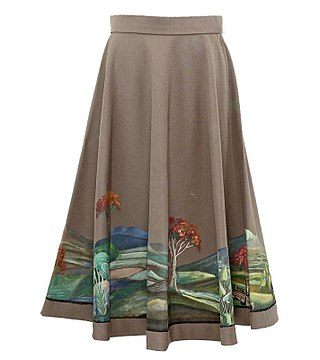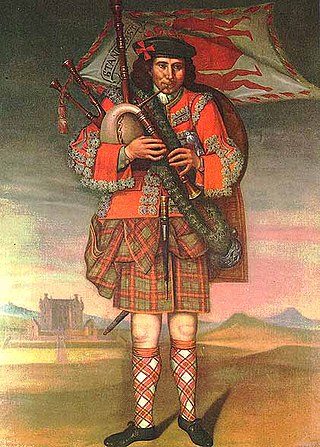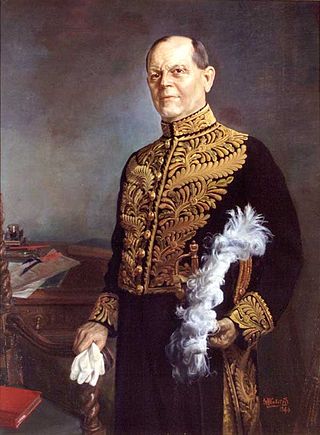
A kilt is a garment resembling a wrap-around knee-length skirt, made of twill-woven worsted wool with heavy pleats at the sides and back and traditionally a tartan pattern. Originating in the Scottish Highland dress for men, it is first recorded in 16th century as the great kilt, a full-length garment whose upper half could be worn as a cloak. The small kilt or modern kilt emerged in the 18th century, and is essentially the bottom half of the great kilt. Since the 19th century, it has become associated with the wider culture of Scotland, and more broadly with Gaelic or Celtic heritage.

A skirt is the lower part of a dress or a separate outer garment that covers a person from the waist downwards.

Tartan is a patterned cloth consisting of criss-crossed, horizontal and vertical bands in multiple colours, forming simple or complex rectangular patterns. Tartans originated in woven wool, but now they are made in other materials. Tartan is particularly associated with Scotland, as Scottish kilts almost always have tartan patterns.

The Dress Act 1746 was part of the Act of Proscription which came into force on 1 August 1746 and made wearing "the Highland Dress" — including the kilt — illegal in Scotland as well as reiterating the Disarming Act 1715. The Jacobite Risings between 1689 and 1746 found their most effective support amongst the Scottish clans, and this act was part of a series of measures attempting to bring the clans under government control. An exemption allowed the kilt to be worn in the army along with its veterans who have served in the military, continuing the tradition established by the Black Watch regiment.

The Glengarry bonnet is a traditional Scots cap made of thick-milled woollen material, decorated with a toorie on top, frequently a rosette cockade on the left side, and ribbons hanging behind. It is normally worn as part of Scottish military or civilian Highland dress, either formal or informal, as an alternative to the Balmoral bonnet or Tam o' Shanter.

Highland dress is the traditional, regional dress of the Highlands and Isles of Scotland. It is often characterised by tartan. Specific designs of shirt, jacket, bodice and headwear may also be worn along with clan badges and other devices indicating family and heritage.

Highland dance or Highland dancing is a style of competitive dancing developed in the Scottish Highlands in the 19th and 20th centuries, in the context of competitions at public events such as the Highland games. It was created from the Gaelic folk dance repertoire, but formalised with the conventions of ballet, and has been subject to influences from outside the Highlands. Highland dancing is often performed with the accompaniment of Highland bagpipe music, and dancers wear specialised shoes called ghillies. It is now seen at nearly every modern-day Highland games event.

Spats, a shortening of spatterdashes, or spatter guards are a type of classic footwear accessory for outdoor wear, covering the instep and the ankle. Spats are distinct from gaiters, which are garments worn over the lower trouser leg as well as the shoe.

The belted plaid is a large blanket-like piece of fabric which is wrapped around the body with the material pleated or, more accurately, loosely gathered and secured at the waist by means of a belt. Typically, a portion of the belted plaid hangs down to about the knees or ankles with the rest of the material being wrapped up around the upper body in a variety of ways and pinned or otherwise secured to keep it in place.

The aboyne dress is the name given to the prescribed attire for female dancers in the Scottish national dances, such as the Flora MacDonald's fancy, the Scottish lilt, and others. Male dancers wear the kilt for these dances, the kilt being a male garment. There are two versions of the aboyne dress in use. Some consider the aboyne as quite suited to the graceful movements of the National dances.

Full dress uniform, also known as a ceremonial dress uniform or parade dress uniform, is the most formal type of uniforms used by military, police, fire and other public uniformed services for official parades, ceremonies, and receptions, including private ones such as marriages and funerals. Full dress uniforms typically include full-size orders and medals insignia. Styles tend to trace back to uniforms used during the 19th century, although the 20th century saw the adoption of mess dress-styled full-dress uniforms. Designs may depend on regiment or service branch. In Western dress codes, full dress uniform is a permitted supplementary alternative equivalent to the civilian white tie for evening wear or morning dress for day wear – sometimes collectively called full dress – although military uniforms are the same for day and evening wear. As such, full dress uniform is the most formal uniform, followed by the mess dress uniform.

Court uniform and dress were required to be worn by those in attendance at the royal court in the 19th and early 20th centuries.

The modern, tailored kilt which is ubiquitous at Highland games gatherings around the world has associated with it an evolving style of wear. This style includes the accessories and other accoutrements which are typically worn with it. In this sense, it is very much like other items of the fashion world.

The uniforms of the British Army currently exist in twelve categories ranging from ceremonial uniforms to combat dress. Uniforms in the British Army are specific to the regiment to which a soldier belongs. Full dress presents the most differentiation between units, and there are fewer regimental distinctions between ceremonial dress, service dress, barrack dress and combat dress, though a level of regimental distinction runs throughout.

The history of the modern kilt stretches back to at least the end of the 16th century. The kilt first appeared as the belted plaid or great kilt, a full-length garment whose upper half could be worn as a cloak draped over the shoulder, or brought up over the head as a hood. The small kilt or walking kilt did not develop until the late 17th or early 18th century, and is essentially the bottom half of the great kilt.

A full plaid, or just a plaid, is a long piece of tartan or checked fabric, most often worn as part of a Highland dress. It usually matches the tartan of the kilt. A modern full plaid is pleated the whole way, with half of its length sewn shut. Its length is about twice the distance from the ground to the wearer's shoulder.

Service Dress is the style of khaki service dress uniform introduced by the British Army for use in the field from the early 1900s, following the experiences of a number of imperial wars and conflicts, including the Second Boer War. This variant of uniform continues to be worn today, although only in a formal role, as No. 2 Pattern dress.

"True Scotsman" is a humorous term used in Scotland for a man wearing a kilt without undergarments. Though the tradition originated in the military, it has entered Scottish lore as a rite, an expression of light-hearted curiosity about the custom, and even as a subversive gesture.

Trousers, slacks, or pants are an item of clothing worn from the waist to anywhere between the knees and the ankles, covering both legs separately. In the United Kingdom, the word pants generally means underwear and not trousers. Shorts are similar to trousers, but with legs that come down only to around the area of the knee, higher or lower depending on the style of the garment. To distinguish them from shorts, trousers may be called "long trousers" in certain contexts such as school uniform, where tailored shorts may be called "short trousers" in the UK.

A maud is a woollen blanket or plaid woven in a pattern of small black and white checks known as Border tartan, Falkirk tartan, Shepherd's check, Shepherd's plaid or Galashiels grey. It was in common use as an item of clothing in the southern counties of Scotland and the northern counties of England until the early twentieth century.























